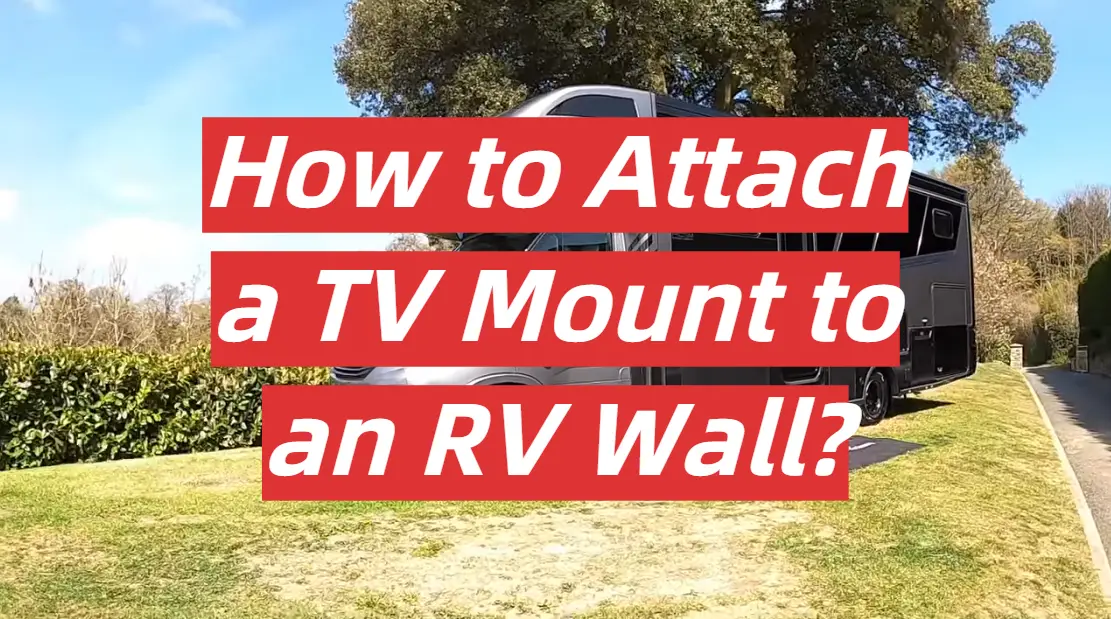RV is the perfect place to escape from everyday life and enjoy nature. But there is one thing that can make it better: a TV! The walls of your RV are typically made from thin particle board that can’t support the weight of a television. This is why most people purchase a TV mount that can be attached to the wall with screws or bolts. If you need help figuring out how to attach one, then read on!
Table of Contents
What You Will Need For A TV Mount Installment?
- A stud finder;
- A marker or pencil;
- Drill and drill bits;
- Wood screws (the mounting kit) or other mounts;
TV Mount Installation Process
- Place your TV on the wall mount;
- Mark where you are going to drill holes using a pencil onto the back of your TV or wall, then remove both of them together from their places;
- Drill pilot holes into these markings with an appropriate sized drill bit for whatever screws you have in order to prevent cracking and breaking. You might want to make sure that they are not too big as well, which would be bad because they won’t hold up tight enough against the RV walls. Make sure there is some wiggle room so that when tightening everything later on it will work out just fine;
- Attach your mounts by screwing them into place making sure they are secure but also easy enough for future removal and installation. You don’t want them to be too tight that you end up breaking the mounts or your walls, but also not loose enough where they move around and fall off;
- Place it back in its place by marking this time with a pencil onto which holes need to go through using the marks from earlier as a guide for reference so everything lines up just right;
- Drill these pilot holes once more into the wall/TV before reattaching both securely in order to have everything ready for when putting it all together later on;
- Screw TV mount brackets firmly into place making sure there is no wiggle room again. If there are extra screws left over then keep going until the drill runs out or can see none are sticking out anymore and you’re done;
- Make sure the TV is secure and attached properly before taking a look at it while standing back to make sure everything looks straight. If not, then take out all of the screws again and adjust them accordingly until they are perfect for your viewing pleasure;
- Connect cables by inserting them into their appropriate places such as power cords where needed in order to get yourself up and running quickly without any problems or interruptions. You don’t want anything hanging loose that could be dangerous or unsafe so always double-check what you have plugged in just to be safe;
Types of TV Mounts for RVs
Fixed Mounts
A fixed mount is the most common type of TV bracket for RVs. This style mounts directly to a wall or cabinet with hardware that can be tightened into place after the installation, ensuring it doesn’t move an inch once in its proper spot. It also allows your television to swivel at varying degrees so you can find the ideal viewing angle when seated on any seat in your RV.
Fixed mounts are generally more stable than articulating arms but may not always hold larger televisions as well if they are heavier and have wider bases, due to their limited range of motion.
Fixed mounts are the most popular style of TV brackets for RVs because they provide a stable and secure base to keep your television safe from damage. They also allow you to adjust it so you can view it while seated in any seat throughout your vehicle, ensuring comfortability on all trips. If you’re looking for an easy installation with high stability that will hold larger televisions without the worry of them falling off the wall or tipping over, then this is a perfect choice!
Tilt Mounts
Tilt mounts are a step up from fixed TV brackets because they allow you to adjust the angle of your television for comfortability while seated in any seat. These types of RV wall mounts have an adjustable arm that allows them to pivot and tilt towards where you’re sitting, ensuring there is no glare on your screen when darkroom conditions occur or if someone is trying to sleep behind it.
The main disadvantage with this style of mount compared to fixed ones is that they can’t always hold larger televisions as well and can be more expensive than other styles. The base may also require additional hardware such as ceiling braces that would complicate the installation process further. However, these kinds of brackets offer added convenience so if saving money isn’t a concern and you don’t mind a more complicated installation, this style may be the best choice for your RV.
Articulating Mounts
Articulating arms are the most advanced type of TV bracket for RVs, offering a full range of motion to your television while it’s mounted. This allows you to move and pivot the screen in any direction so that there is no glare or person behind it who may be trying to sleep.
These types of brackets keep larger televisions stable throughout installation but can also hold smaller models just as well if they have wide bases.
The only disadvantage with this style compared to fixed ones is that they typically come at a higher price due to their increased stability features, which are not required on cheaper mounts made from plastic materials.
They also require additional hardware such as ceiling braces when being installed into ceilings with difficult angles compared to tilt styles where this isn’t required. However, articulating mounts offer the most positioning freedom and make it easy to view your television from any vantage point!
Full-Motion Mounts
Full-motion mounts are the most advanced and versatile TV brackets for RVs because they can be adjusted in almost any direction. These types of mounts offer movement throughout the entire arm so you can move your television up, down, side to side, towards or away from a wall as well as rotate it in circles!
They’re an excellent choice if you have multiple people trying to watch something at different angles but require additional hardware such as ceiling braces when being installed into ceilings with difficult angles compared to tilt styles where this isn’t required.
These kinds of RV wall mount brackets are perfect if you want maximum flexibility with positioning while maintaining high stability throughout the installation. If saving money is not a priority then these may just be what you need to get the perfect viewing angle for your television, no matter where you’re sitting in your vehicle!
Pro Tips
Use Adhesives for The Screws
Use adhesives for the screws to attach your TV mount. This will keep it from rattling and add extra support so it won’t pull away from the wall when you start screwing in your TV’s bolts with a power drill.
Hide Cables in The Wall
Hide cables in the wall to keep your entertainment center from looking cluttered. This is an excellent way to hide unsightly wires as well as increase safety by preventing people from tripping over them.
Use a stud finder
Use a stud finder to locate the wood framing behind drywall and mark it with a pencil so you know where to place nails for added support if needed before drilling holes using a power drill. Then, run plastic cable covers along each stud or beam at least 12 inches off the floor and secure all cables inside before attaching the TV mount securely into position on RV walls.
In addition, you might be interested in following articles:
FAQ
Can you screw into RV walls?
Absolutely. Most of the time you can use lag bolts to attach mounts. If there is spacing, like on an exterior wall between cabinets, you will need toggle bolts or sheet metal screws (a.k.a. star drive). You want to make sure they are long enough and not too short so that when it’s tightened down there isn’t any wiggle room for your TV.
Command strips are not strong enough and are way more expensive than proper screws/bolts/brackets in most cases anyway. Think about it: when was the last time your TV came crashing down during an earthquake or tornado? These things stick up high on walls so they are easy targets for thieves too!
There is no good reason to come at an extra cost using these adhesive products. No matter what mount you get, make sure there are screw slots included and that it’s VESA compliant (most mounts today list this).
Can you mount a TV on a trailer wall?
There may be specific technical issues that prevent mounting a television onto an RV wall or cabinet. The material used for construction can affect whether it is possible to hang anything from them at all. Some materials, like aluminum and certain types of plastic, cannot support any weight without bending or warping under pressure over time.
While something made out of wood might not have these problems if properly constructed, many RVs use particle board – which isn’t suitable for hanging objects off because it doesn’t hold nails well enough to keep boards attached after they take on some weight.
If it’s a steel wall, you will need to pre-drill the holes with a metal drill bit.
What is an RV stud?
RV studs are metal bolts that extend out of the wall. They come in different sizes, depending on where you’re mounting your TV mount to and what size TV is being mounted.
How do you find studs in an RV wall?
Studs are metal screws that hold the wall together.
To find them, look for a smooth part of your wall with no texture or finish on it. This is where you can start drilling into your walls and attaching things like mounts or shelves to keep everything organized in a tiny space.
There will be studs every 16 inches all around an RV wall, so once you have found one of these areas use a level to measure out from this spot both ways until you get another “stud” area at another 15-inch mark if possible (or whatever height you need). If there is not enough room between studs go up/down slightly from each other rather than side by side if needed.
Can you mount a TV wall without drilling?
Mounting a television on an RV can be difficult. If you are in doubt about whether or not it will take the pressure, then wait until your next stop and do some research before moving things around inside your RV while driving down the road.
The safest option would likely involve placing something like Velcro between two boards somewhere that would hold up well underweight and still allow for easy removal once you’re ready to get rid of them. This method doesn’t require nails or screws but does make use of glue – which might create problems if you ever need to remove whatever was holding them together later because pulling apart glued surfaces tends to damage both parts beyond repair.
Can I use a regular TV mount in my RV?
Yes, you can use a regular TV mount.
Do you need a special TV mount for your RV?
A TV mount can be universal or specific to a manufacturer. If you have the original manual for your RV, it should give instructions on how to install the TV mount. Since RVs are all built differently, there are no one-size-fits-all solutions when attaching a TV mount inside an RV.
How much weight can an RV TV mount hold?
To ensure you are choosing the right TV mount for your RV, it’s important to check out how much weight each model can hold. The rule of thumb is that a TV should weigh no more than half of what the wall mount holds—so if an RV mounted wall bracket claims it will support up to 35 lbs., then choose a monitor weighing under 17 pounds.
What size screws RV walls?
RV walls are typically made of metal and do not have a standard thickness. The best way to determine the size screws you need is by using a stud finder and measuring the width of your TV mount’s holes on the back. If this doesn’t work, start with #12 or #14 wood screws which can always be removed later if they don’t hold well enough.
If possible, screw directly into wall studs for maximum support as they will provide more stability than just attaching it to drywall alone. Be sure that whatever material the RV wall is made out of (metal, plastic) does not interfere with any electrical components in order to prevent fire hazards!






Leave a Reply